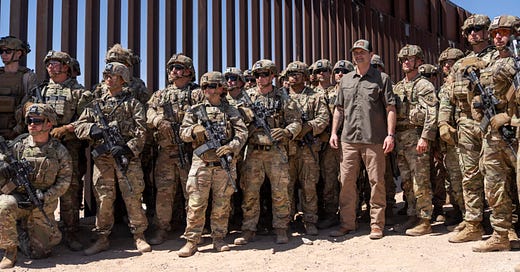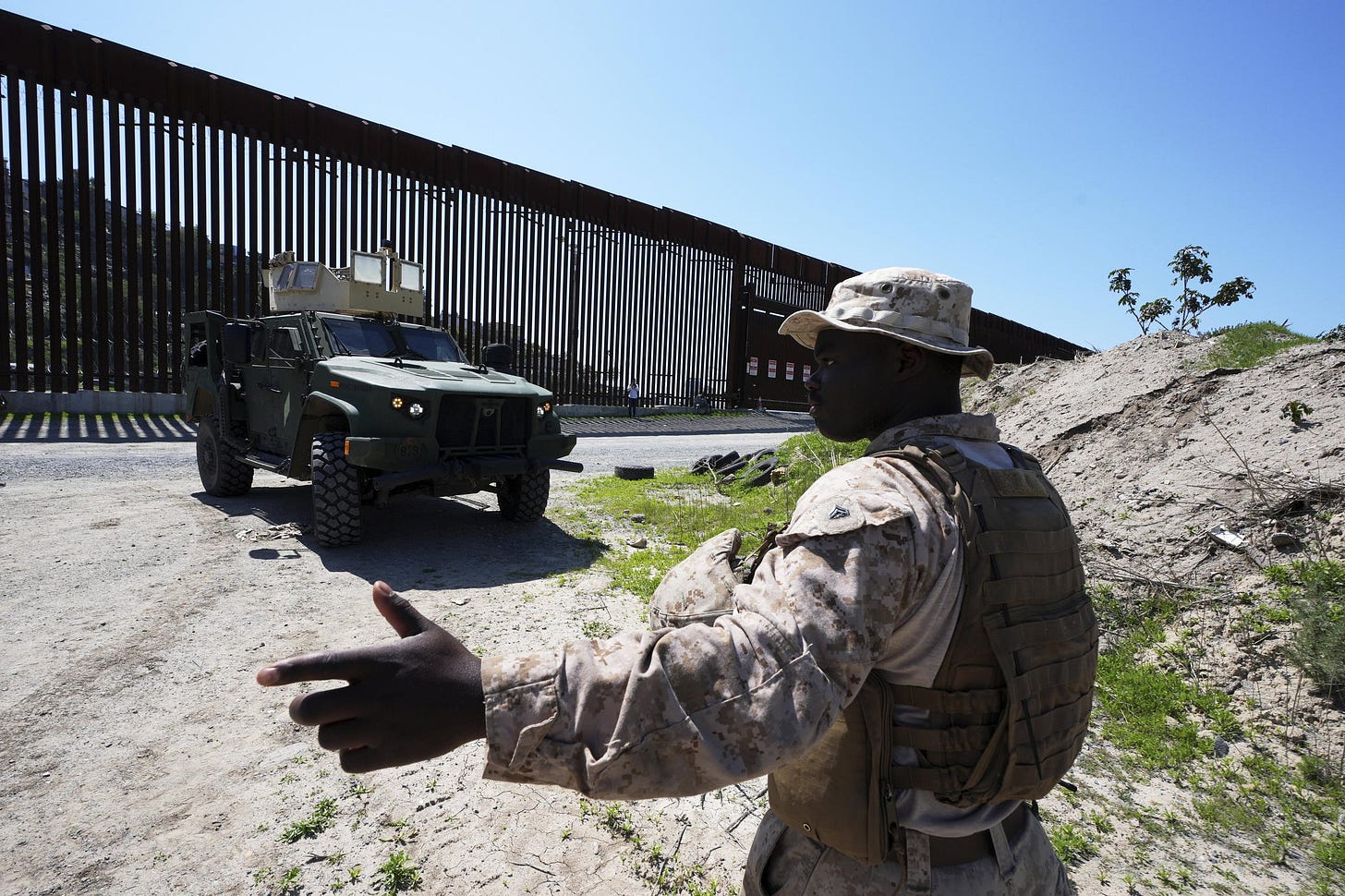Pentagon to expand military presence along southern border with two new defense zones
Nearly 9,000 active-duty troops are now supporting border operations, transferring immigration detention facility management to the Army, reflecting a dramatic shift in the military's domestic role.
By Laura Harris
June 29, 2025
The Pentagon is establishing two new National Defense Areas (NDAs) along the southern border, one connected to Joint Base San Antonio (250 miles along the Rio Grande) and another near MCAS Yuma (over 100 miles), to expand military enforcement against illegal crossings.
Nearly 9,000 active-duty troops are now supporting border operations, with additional surveillance aircraft, Navy ships and combat units from the Army's Fourth Infantry Division deployed across the region.
Troops in these NDAs are authorized to detain migrants for trespassing until handed over to law enforcement, signaling an expanded military role in domestic immigration enforcement.
The Trump administration has repurposed military resources for deportation efforts, including flights to Guantanamo Bay, with intelligence units and surveillance aircraft redirected to border monitoring.
The administration plans long-term deployments, up to four years in some areas, building temporary housing and transferring immigration detention facility management to the Army, reflecting a dramatic shift in the military's domestic role.
The Department of Defense is preparing to establish two new military zones along the southern border amid ongoing concerns over illegal border crossings.
According to three U.S. officials, the zones, designated as National Defense Areas (NDAs), will be formally attached to Joint Base San Antonio in Texas and Marine Corps Air Station (MCAS) Yuma in Arizona.
The NDA connected to Joint Base San Antonio will stretch along approximately 250 miles of the Rio Grande, while the NDA near MCAS Yuma will span more than 100 miles of the U.S.-Mexico border.
(Related: REPORT: 6,000 Iranian Migrants on ICE ‘Non-Detained’ Docket May Soon Face Arrest
Nearly 9,000 active-duty troops are now assigned to the mission, which includes ground forces from the Army's combat-experienced Fourth Infantry Division, surveillance aircraft and U.S. Navy ships positioned offshore.
These additions mark a continued expansion of the military's presence along the border, bringing the total number of NDAs to four.
The new zones follow the recent creation of the Texas NDA attached to Fort Bliss in May and the New Mexico NDA linked to Fort Huachuca in Arizona in April.
"The establishment of a second National Defense Area increases our operational reach and effectiveness in denying illegal activity along the southern border," U.S. Northern Command commander Gen. Gregory Guillot said after the establishment of the Texas National Defense Area.
"This is the second area in which Joint Task Force – Southern Border service members who are already detecting and monitoring through stationary positions and mobile patrols nearby can now temporarily detain trespassers until they are transferred to an appropriate law enforcement entity."
Both areas will be actively patrolled by U.S. troops, and officials say that any unauthorized entry into the zones will be treated as trespassing.
Individuals who enter these zones illegally may be detained by military personnel until U.S. Border Patrol agents arrive.
Trump administration leans on the U.S. Military to fulfill its ambitious mass deportation plan
This move is part of the broader plan to use the military in the mass deportation plan of President Donald Trump.
In March, more than 11,000 troops, including over 6,000 active-duty service members, were already deployed under federal authority.
From the deserts of Arizona to the rural towns of West Texas, armored Stryker vehicles and combat brigades, typically reserved for overseas operations, were already a regular sight.
In Presidio, Marfa and Alpine, Texas, small towns near the Big Bend region, around 500 soldiers have been deployed, a staggering number for communities that collectively house fewer than 10,000 residents.
The troops were expected to stay for six months to four years, with discussions underway about building temporary military housing at local airports.
Officials also deputized hundreds of Texas National Guard troops, giving them limited authority to apprehend migrants under the supervision of U.S. Border Patrol.
The administration also revived and expanded the military's role in deportation logistics.
At least 74 migrants flew to Guantanamo Bay, where they were detained in a military-run prison more often associated with terrorism suspects.
The military’s intelligence apparatus was also mobilized.
Over 100 surveillance sorties flew by advanced aircraft, including Global Hawks, U-2 spy planes and RC-135s.
Forty intelligence analysts from the Air Force were recently assigned to border-related tasks.
At Fort Bliss in El Paso, Defense Secretary Pete Hegseth authorized the Army to take over the construction and management of immigration detention infrastructure, a dramatic departure from its traditional role.
In other words, the Trump administration is increasingly turning to the U.S. military to realize its ambitions of mass deportations and a near-total freeze on immigration.
How Trump Is Leaning on the Military to Fulfill His Hopes of Mass Deportations and an Immigration Freeze
A Marine helps guide a vehicle during a news conference on joint operations involving the military and the Border Patrol, Friday, March 21, 2025, in San Diego. (AP Photo/Gregory Bull)
For transportation, detention, and potentially apprehension of migrants, the Trump administration is looking to the military.
Sixty feet. Nearly the length of a bowling lane.
That's the width of a stretch of federal lands nestled at the U.S.-Mexico border called the Roosevelt Reservation, named for the 26th president who established it to try to limit smuggling in the early 1900s.
Nearly 120 years later, President Donald Trump is considering using the strip as a speed trap migrants would have to clear to escape patrols by the U.S. military.
Military.com confirmed with a U.S. official that parts of the land, which stretches across California, Arizona and New Mexico, may be transferred to the Department of Defense under a "pre-decisional" plan waiting to be signed by the commander in chief.
The move, as first reported by The Washington Post, would essentially provide legal cover for active-duty service members to apprehend migrants who cross on to what would become Department of Defense property, making it essentially no different than if anyone trespassed onto a U.S. military base.
It would be a way for active-duty troops to avoid violating Posse Comitatus -- a federal act that prevents the U.S. military from performing law enforcement activities.
While U.S. troops have been deployed to the border before, that law has meant that they have played a supporting role, providing intelligence and infrastructure repair and construction assistance, rather than the direct handcuff-and-detain-migrants role the Trump administration has envisioned.
The change to the Roosevelt Reservation would be the latest in a long line of moves by the administration that represents something of a spaghetti method of using the military to try to speed up deportations, whether it be using service members for transportation, detention or potentially apprehension along the border, while parrying a barrage of lawsuits challenging the legality of deportations that come with minimal legal oversight.
Military.com spoke to current and former senior military officials as well as a range of experts on defense and civil rights policy about the actions taken by the Trump administration to alter how the U.S. handles migrants and undocumented immigrants currently living in the country.
The current and former officials requested anonymity in order to discuss military operations.
Some of the policy experts expressed concerns at the vast expenditure of resources and potential use of legal grey areas that are being pushed by the administration, which has tasked the Pentagon with taking over more and more of the responsibility for immigration enforcement.
"Military deployments at the border don't seem to be connected, at least on this side of the border, with deterring migration," Danny Woodward, an attorney with the Texas Civil Rights Project, told Military.com. "We are hugely concerned about things we've been hearing using military resources for detention and deportation."
READ MORE:
President Trump Authorizes Military to Occupy Public Land Along US–Mexico Border and Repel Invasions
The 15 years That Destroyed America
Share or comment on this article.
Your support is crucial in exposing fake news and in helping us defeat mass censorship.






NOW! Who's going to oppose this other than Congressional Democrats, RINOS, and their allies in the Fake News Media? It's going to be interesting! Come on, exposes yourselves!! 👀
Not a bad idea being that they couldn't keep them from coming in that is the gang members and real terrorist and just ran the gate not being able to stop this then fake news saying so many were on the TSDB illegal targeting program which is a lie because 97 percent should not be on it . I believe in my opinion it was literally done on purpose to place more on the list. Just call them all terrorist. And a genocide letting the drugs come in killing thousands of civilians and allowing the gang member into this country to hire them for the TSDB iligal targeting program who are not like those that come here with no criminal background and just want to work and make a living. Once under control I'm sure the military will be moved elsewhere. It is the Bidens doing . This is part of deweaponization of government.